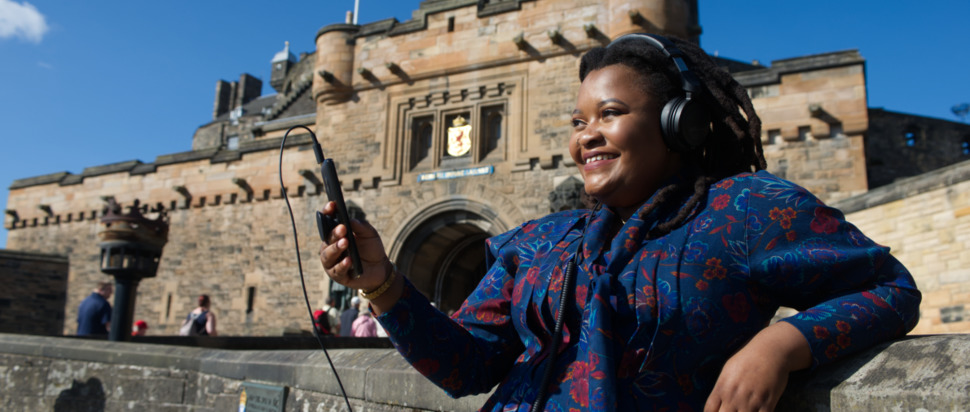Tanatsei Gambura on new installation Nzira Yeparuware
Tanatsei Gambura's new installation at Edinburgh Castle fuses the sounds of Harare and Scotland's capital city – and discusses their inevitable entanglement
Amidst the hectic crowds climbing the Royal Mile to Edinburgh Castle, voices and noises clash in one of the Scottish capital's most popular tourist attractions. Among the grey stones and the typically gloomy Edinburgh sky, the stillness and colour of a bright yellow box stands out, signalling the presence of Tanatsei Gambura’s Nzira Yeparuware (Shona for 'a path upon a rock', drawn from a longer proverb that translates as 'only the one who walks upon a rock knows a path is there').
Created by the Harare-born artist for The University of Edinburgh’s Managing Imperial Legacies project, it is composed of eight soundtracks that can be listened to in specific locations throughout the castle. Each site is indicated by colourful signposts in yellow, red, green and black, which both visually stand out among this grey-dominated landscape but also invoke the Zimbabwean and Pan African flags, staking out a space at the symbolic heart of Scottish history and identity. Gambura says this stands as a metaphor to assert “the right to be different and be other, to come from somewhere else, not to be Scottish and to be here.”
Having moved to Scotland in 2019, Gambura realised that many streets and suburbs in Harare were named after Scottish places. These Scot-named sites tangibly represent one legacy of the 19th century colonisation of Zimbabwe by the UK (including many Scots), who “stamped their mark” on the landscape, society, and culture of the nation. “One of the most effective things colonialism does is erase indigenous experiences and remove the right to imagine yourself differently,” commented Gambura. As a response, Nzira Yeparuware was developed as an imaginative and anticolonial work to ask what indigenous people would make of their own geography given the opportunity: “what would be here if not this, how would I be if Zimbabwe was not colonised?” reflects the artist.
The eight tracks of Nzira Yeparuware consist of field-recordings collected in Harare locations with Scottish place names, spoken word elements and musical improvisations developed in response to them by The Edinburgh Composers Orchestra. The result is an immersive work capable of transporting people across national borders and into alternative geographies. Harare’s geographical panorama unravels as music intertwines with the city’s background noises and Gambura’s voice, producing harmonic and dissonant combinations to express the city’s urban complexity. Nzira Yeparuware is also a time-specific experience, in the way that unique layers of sounds from the surroundings of Edinburgh Castle mingle with the recordings.
Gambura recurs to sound for its ability to guide listeners to imagine and feel another place. “Through sound, there is a sense of empathy and understanding to grasp the experience of being from and in another place, related to the one where you are standing right now,” she says. While the immersive nature of the soundscape blurs the two national realities, Gambura underscores that this coming together is not meant to be harmonious. The sounds of Harare and the music compositions speak of a warm urban landscape dissonant to visitors’ experience of Edinburgh. Likewise, Gambura’s calm voice and the length of the soundtracks invite visitors to slow down, in contrast with the excited chatter of this fast-paced environment. “There is a feeling of delirium as you are in one place, listening to another place; but in some ways these locations are the same as they share their name.” This soundscape evokes real discomfort and a sense of confusion as listeners try to grasp a reality that doesn’t quite make sense. “As colonialism scrambled people’s identity and experience of reality, I wanted to evoke this tension through clashes that disturbs listeners’ sense of reality, too,” the artist explains.
Linking Scotland and Zimbabwe “doesn’t mean that there is clarity, nor that this is not an antagonistic contact.” Gambura’s selection of Edinburgh Castle among all of Historic Environment Scotland’s sites expresses the artist's intention of seeking out and exploring this tension in a site that is deeply symbolic of Scottish nationalism and history. Nzira Yeparuware's challenge to ideas of nationalism is particularly evident in the track Crown Square, intended to be experienced outside the Castle War Memorial (dedicated to Scottish soldiers fallen during both World Wars and numerous other conflicts). In this track Gambura takes the words inscribed in the building but redirects them to form a eulogy to the indigenous people of Zimbabwe – re recontextualising the sentiment of the memorial to victims of colonialism.
Nzira Yeparuware works towards spotlighting the gaps in Scotland's colonial history, as it brings listeners’ attention to what Gambura defined as a “deep sense of long-term amnesia” about British colonialism’s erasure of indigenous cultures, identities, and landscapes. Through its juxtapositions and tensions, this piece presents the adjacent but removed realities of Scotland and Zimbabwe – linked by their names and their colonial relationship. The artist asserts that this is an artwork not for Scotland, but instead for racialised and colonised people as a space for imagination and to proclaim their presence in the past, present and future of Scotland.
Nzira Yeparuware, Edinburgh Castle, until 30 Nov (included in Edinburgh Castle admission); book tickets via the Edinburgh Castle website
